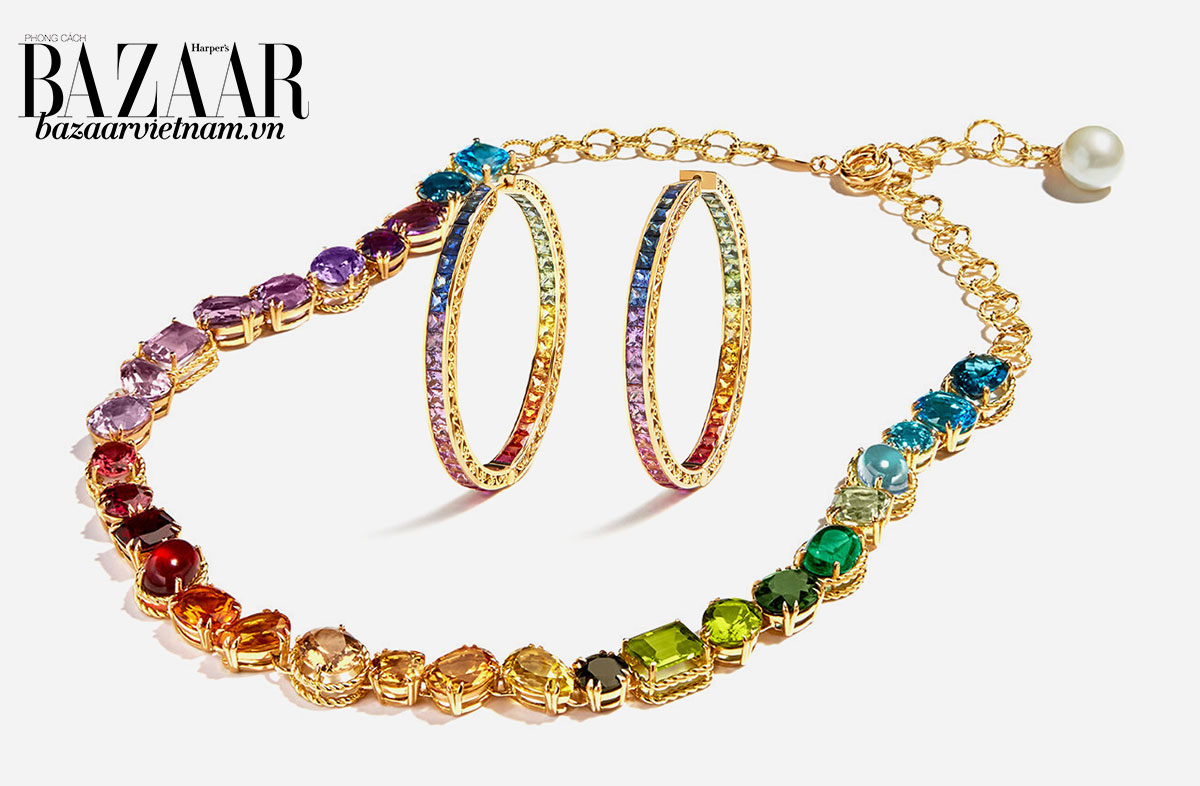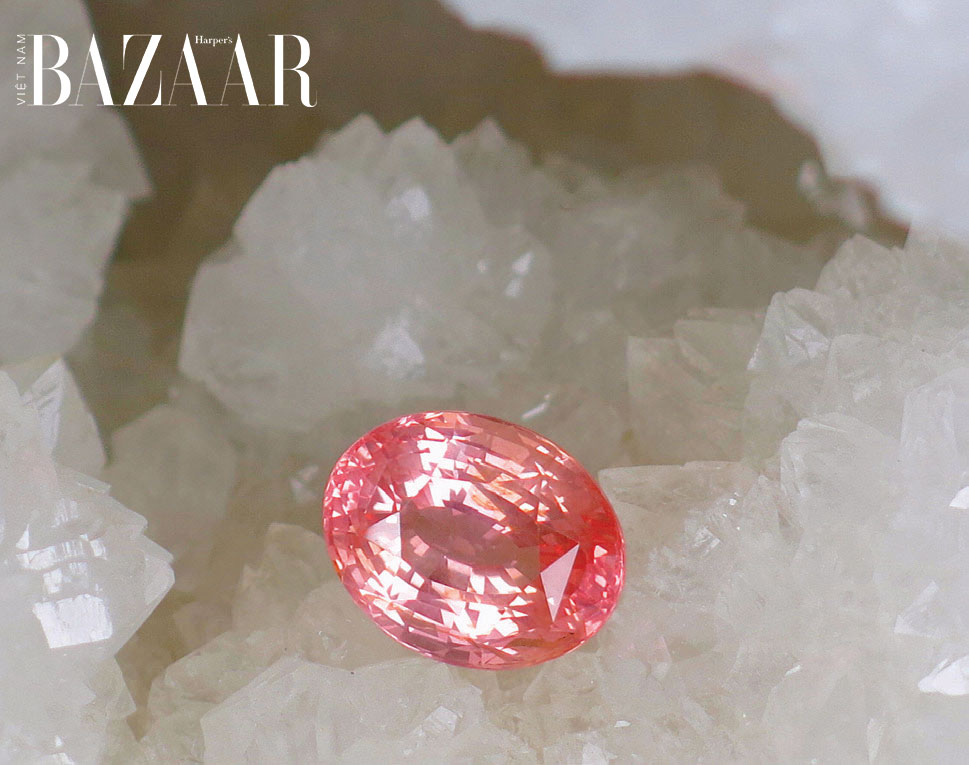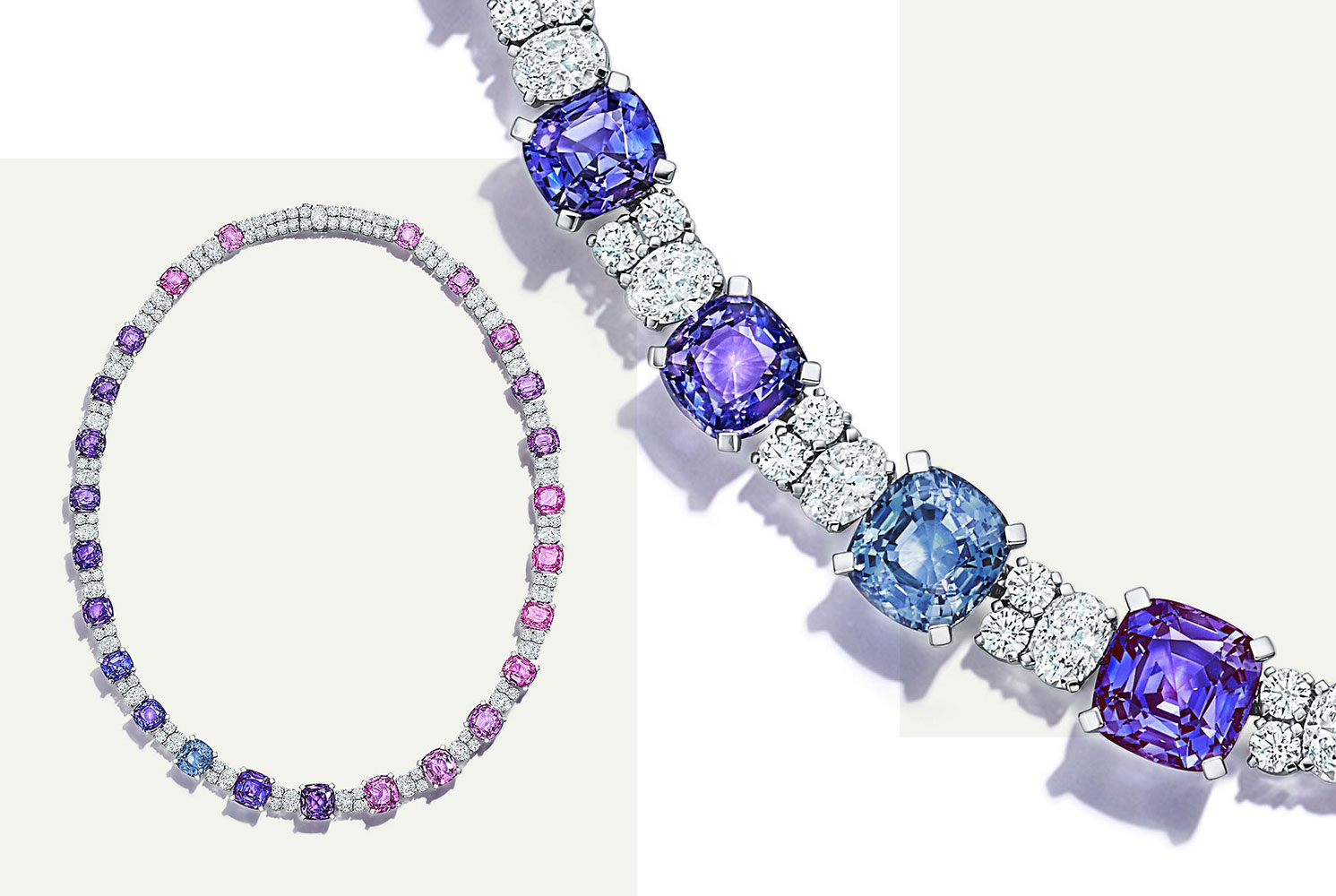
Magnificent platinum necklace featuring round “no-heat” multi-colored fancy sapphires exceeding 85 ct total weight, and accented with oval diamonds, Shreve & Co.
A ruby that displays a reduced red saturation is identified as pink sapphire. Yellowish to greenish and teal color sapphires often occur together in iron-rich basaltic rocks, and various coloring elements can be mixed to the basic corundum composition during the formation of sapphire in metamorphic rocks. Fancy colored sapphires that formed in metamorphic rocks display purer and brighter hues than those that originated from basaltic rocks, the latter being darker toned and less brilliant.
Out of Gondwana

Earrings from the Tie & Dior haute joaillerie collection, featuring paraíba tourmaline, pearls, diamonds, tsavorite, garnet and fancy colored sapphires, Christian Dior.
About 800 to 500 million years ago, South America, Africa, Madagascar, Sri Lanka, India, Australia and Antarctica formed a single landmass known as Gondwana, which means “Land of the South”.
Towards the end of this period these continents collided and formed massive mountain chains. Many rocks were transformed through pressure and heat and generated a great variety of gemstones, including corundum. This geological event is responsible for the occurrence of the rich ruby and sapphire locales in several East African countries, southern India, and Sri Lanka. Today, Tanzania, Madagascar and Sri Lanka are the major sources of fancy-colored sapphires, producing colorful gems of all sizes, qualities, and shades.
The sapphire occurrences that once were situated along the gigantic mountain chain in East Gondwana are now spread around the Indian Ocean. As the supercontinent Gondwana ruptured, landmasses and continents drifted apart, carrying the gemstones with them. On its journey, the Indian plate collided with the Eurasian plate about 60 million years ago to form the Himalayas and neighboring mountain chains in the process. Many gemstones were formed during these dynamic geological processes, including the fancy-colored sapphires found in Myanmar, northern Vietnam, Nepal, northern India, Pakistan, Afghanistan, and Tajikistan. Since they were formed in iron-poor metamorphic rocks, these gems are often bright and beautiful.

Necklace and earring set featuring fancy colored sapphires, amethyst, peridot… from Dolce & Gabbana
FUN FACTS ABOUT FANCY SAPPHIRESPink Sapphire: Wear your pink sapphire at the in the UV light of your favorite discotheque, you will be surprised how bright it glows! Orange Sapphire or Padparadscha? Orange sapphires are scarce and valuable too, even though they are not padparadschas. Yellow Sapphire is the brightest vivid yellow gemstone after fancy vivid diamonds. Color Change Sapphire: An elusive variety of sapphire exists, that can change color depending on the source of light. Traces of metal impurities and a complex electronic interaction between them are responsible for this color change Imitations: Synthetic fancy colored sapphire, other natural or synthetic stones, composite corundum with glass, assembled stones, glass. Price/value for finest quality on a scale from 1 (lowest) to 10 (highest): Padparadscha = 8; pink sapphire = 7; black sapphire = 1 |
The many colors of fancy sapphire
Padparadscha: Color of the lotus
Imagine a sapphire that displays the warm colors of a spectacular sunset, with a delicate balance of pink and orange blended with a light to medium saturation. This description corresponds to the rarest of all fancy colored sapphires: the padparadscha. Its name is derived from the Sanskrit “padma-raga”, which means “King of the Lotus”, a pink-orange lotus blossom that is indigenous to Sri Lanka.
Fine quality padparadschas are exceptionally rare because their subtle tint results from a combination of several chemical and physical causes. The most valuable is a medium to medium-intense saturated, well-balanced half orange and half pink color. Some prefer a slight pink dominant, while other favor a stronger orange component. It is like people: some are early birds; others love the sunset!

Padparadscha rings from 2009 haute joaillerie collections of Chanel and Cartier. Photo: RobbReport
Sri Lanka is the traditional and historically most significant producer of padparadscha; it was the sole producer of this mysterious sapphire variety until the discovery of some new sources in Tanzania and Madagascar.
With the exception of the finest specimens from Sri Lanka, the most beautiful padparadschas the author has ever seen, were found in the 1980s in the Luc Yen region of northern Vietnam. As I was walking through the offices of one of the most prominent gemstone merchants in Bangkok, I was attracted by the phenomenal luminosity of these pinkish-orange sapphires, even though they were lying on a table nearly fifteen meters afar. I was fortunate to be able to inspect them closely, but regrettably never saw them again!
Buying tips: Like with any other sapphire, correct identification and full disclosure of treatments are of primary importance when considering buying a padparadscha. Most padparadschas are routinely heated; but buyer beware, some are irradiated, some might fade, and the marketplace is crowded with imitations.

No heat padparadscha from Sri Lanka. Photo: © Roland Schluessel
Pink sapphires: The most popular variety
Any corundum that has a color saturation that is too weak to be ruby red is called pink sapphire, no matter if the gemstone originates from a ruby deposit.
The limit between pinkish-red ruby and reddish-pink sapphire is not standardized and can, in borderline cases be a matter of debate; particularly because the price difference between a corundum called ruby and a pink sapphire is significant.
There are differences in pink sapphires; not only between very pale pink and vivid pink, but also in the presence or absence of a tone or slight secondary color such as orangey or purplish.
Some vibrant to vivid pink sapphires are brightened up by a strong red fluorescence; this increases their attractiveness and value, particularly if they originate from the marble rocks exposed in the legendary Mogok Valley in Myanmar or Luc Yen in northern Vietnam.

Limelight Gala watch, 32 mm. Case in 18K rose gold set with 10 brilliant-cut diamonds (approx. 0.90 ct) and 32 pink sapphires (approx. 4.70 cts), Piaget
Purple: A mix of ruby and sapphire
A purple sapphire is about half ruby and half sapphire. Thus, purple sapphires can have a blue dominant or a red dominant; they are particularly attractive when they show vivid color flashes and are not dulled by a murky tone. The purplish to violet component is more evident in incandescent lighting conditions.
The most significant sources for purple sapphires are Sri Lanka, Madagascar, Mozambique and Tanzania.

Necklace in platinum with unenhanced pink and purple sapphires, from Tiffany & Co‘s Colors of Nature 2021 high jewelry collection.
Yellow like the sun
Yellow gemstones are particularly popular in Indian culture, where it is the Monday’s color of the week. According to Vedic traditions yellow has a significant connotation because it represents the third Chakra; like in many African cultures, it is the “Energy Color” of the solar plexus.
In Chinese culture, yellow is associated with a stabilizing energy and keeps Yin-Yang in balance. Yellow sapphires are not particularly rare; however, yellow sapphires with a pure yellow color and vivid saturation are scarce in sizes exceeding 10 carats. A straight yellow hue, or a yellow with a warming golden secondary color are the most desirable.
Sri Lanka is the traditional supplier of fine yellow sapphires, but since the 1990s, beautiful gems have also been found in East Africa, particularly in Madagascar.
Buying tips: Avoid a “windowed” yellow sapphire; when the stone is cut too flat, the yellow sapphire loses part of its brightness, and significantly reduces its beauty. Further, high quality gems are expected to be eye-clean.

Dior à Versailles Côté Jardins Sapphire Enceladus Grove brooch with diamonds, emeralds, tsavorites and sapphires in colors of blue, pink purple and yellow.
The green series: mint, teal and peacock
Sapphire does not occur in a pure green like emerald. In sapphires, it is the element iron that generates a toned blue, or yellow, or a mix of both colors that blend into greenish.
Most of the more transparent gems are “metamorphic sapphires” mined in Madagascar; darker toned stones are usually from the iron-rich basaltic sources, mainly from Australia, Thailand, and some African nations. Green sapphires are generally tarnished by a gray tone, mostly mixed with some yellow, blue, brown, or gray; consequently, it is better to use the term greenish rather than green. The author uses the term “green series” to include all greenish shades ranging from yellow green to blue green, including olive-green, mint-green, teal, peacock and even parti-colored sapphires that show at least some green.
Many sapphires from the green series are heated to improve their transparency and lighten up their color. Bright, less saturated greenish sapphires are rarer but more pleasant than dark ones. For example, bright mint- green sapphires are so rare that they rarely come in sizes exceeding two carats; they are mostly sourced from Madagascar and Montana in the United States.

High jewellery bracelet in platinum, five cushion-shaped green sapphires totalling 30.89 carats, six cushion-shaped yellow sapphires totalling 29.18 carats, two oval- shaped yellow sapphires totalling 5.24 carats, brilliant-cut diamonds, Cartier
ABOUT THE AUTHOR: ROLAND SCHLUESSELRoland Schluessel was born in Switzerland and spent part of his childhood in Milan, Italy. After graduating from business, management, and marketing schools in Switzerland, he studied gemology in Germany and London, Great Britain, where he was awarded the Rayner Prize in 1985. During his numerous travels to the gemstone centers and mining sites in South America, Africa, Europe and Asia, Roland captured more than 200,000 pictures of gem mining, gemstones, and geological processes such as volcanic eruptions. Roland Schluessel resides in San Francisco. Together with his wife Nata, they own the gemstone wholesale company Pillar & Stone International specializing in fine colored gemstones and jadeite. Roland is also the author of a book about Rubies and Sapphires from Myanmar. |

Rings, bracelet and pendant necklace featuring fancy coloreds sapphires and diamond set in platinum, Shreve & Co
WHERE TO SHOP: SHREVE & COEstablished in 1852, Shreve & Co. is the oldest retailer in the state of California with locations in downtown San Francisco and Stanford Shopping Center in Palo Alto. As curators of modern luxury, we are committed to providing an exceptional shopping experience while always creating an opportunity for discovery. Each glance throughout our stores exposes a refined array of handcrafted jewelry and timepieces – a chance to reveal the new and different to those who appreciate the world’s most beautiful things. Shreve & Co. is proud to be home to Rolex, Patek Philippe, Panerai, Tudor, IWC, Vacheron Constantin, A. Lange & Sohne, Hearts on Fire, Harry Kotlar, Mikimoto and many more. To discover more from Shreve & Co., Tony Gross can help begin your journey. Please email tgross@Shreve.com to get started. Or, you can visit the official website shreve.com. |
Harper’s Bazaar Vietnam





